Pimples are inflammatory elements of the skin that appear due to increased activity of the sebaceous glands. Because of this, changes occur not only in the skin, but also in the follicle. Acne can cause infection. Despite the fact that the immune system tries to fight, pus remains under the skin in large quantities. This is very dangerous for your health. Not only teenagers, but also adults are susceptible to acne. As a result, depression and the occurrence of various diseases.
The main causes of acne
Many people ask the question: “What causes acne on the face?” The photos published in this article clearly show how much even a person’s appearance can change, not to mention what happens under the skin. There are many reasons for acne. The most common are hormonal imbalances or changes caused by age. But there are other reasons.

So, let's look at what causes acne on the face:
- excess subcutaneous fat;
- hereditary predisposition;
- poor nutrition;
- stress;
- a lot of dead cells under the skin;
- skin damage;
- inflammation;
- poor facial skin care;
- menstrual cycle;
- lipid metabolism is disturbed;
- the stratum corneum of the skin is enlarged;
- diseases of the stomach and intestines;
- impaired immunity;
- exposure to harmful microorganisms;
- improper use of cosmetics;
- working with toxic substances;
- climate impact;
- excessive cleanliness;
- medicines.
Foods that cause acne
All the reasons listed above are not a complete list of what causes pimples and acne on the face. Sometimes they appear suddenly. Common products that can help with this include:
- Coffee. It should not be drunk on an empty stomach.
- Animal fats. It is better to replace them with vegetable ones.
- Nuts. You should not eat a lot of walnuts, pistachios and almonds.
- Dairy products. It's better to eat low-fat ones. Eat less cheese and ice cream.
- Sweets (candy, sugar, soda, chocolate, etc.).
- Flour products, especially cakes, chips, cookies.
How to choose treatment?
For effective treatment it is necessary to assess the severity of the disease. You can photograph all areas of the skin where pimples, blackheads and blackheads are visible. They determine the degree of the disease. Black dots need to be counted and compared with the scale:
- mild – less than 10 (grade I);
- average – 10-25 (II degree);
- heavy – 26-50 (III degree);
- very severe - over 50 (IV degree).
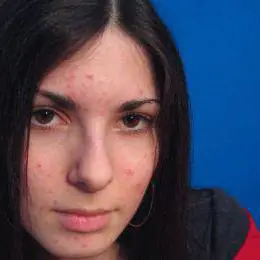
Already formed inflammations (pimples and blackheads) are also calculated in order of increasing degree:
- 1st degree – less than 10;
- 2 tbsp. – 10-20;
- 3 tbsp. – 21-30;
- 4 tbsp. – over 30.
Acne on the face
What causes acne on the face? On the forehead, such inflammations most often form due to the large production of sebum. This area of the face contains many sebaceous and sweat glands. Acne and pimples can appear due to diseases of the gallbladder, pancreas, intestines and stomach.
Inflammatory formations above the eyebrows indicate intestinal irritation. Pimples located closer to the hair indicate a malfunction of the gallbladder. The appearance of acne directly on the forehead means possible intoxication of the body as a whole. Acne on the chin indicates a disorder of the digestive or endocrine system.
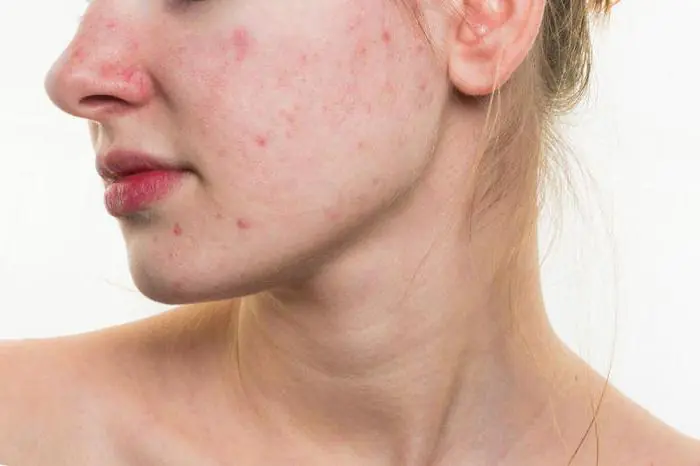
Pimples that appear on the nose occur due to hormonal imbalance. This is usually the teenage period. If this phenomenon is observed in an adult, the immune system, digestive or endocrine system may be impaired. pimples on the bridge of the nose are a consequence of liver overload and poor blood purification. Pimples appearing on the lips indicate a violation of the digestive system, and on the cheeks - an overload of the lungs.
Acne in children
Pimples often appear in babies. If they are white, you don't have to worry too much. This is most likely milia (blockage of the sebaceous glands). Such rashes go away on their own after a couple of months. Sometimes acne appears in a child due to allergic reactions. But they can also indicate diseases. Most often, acne in children appears as a result of measles, scarlet fever, rubella, and chickenpox.
Skin problems in adolescence
Acne on the face of a teenager most often appears as a result of puberty, since hormones are responsible for the functioning of the sebaceous glands. During this period, a large amount of secretion is produced. And this is a very favorable environment for the growth of bacteria. As a result of an increase in their numbers, inflammation manifests itself in the form of pimples and blackheads.
It is very difficult to treat them during this period, since the reason lies within the body itself. Please note that everyone's skin is different. This means that treatment is selected strictly individually. But there are some general tips:
- daily facial skin care;
- regular contrast washes twice a day (with hot water and then cold);
- use of facial scrubs;
- use of steam baths.
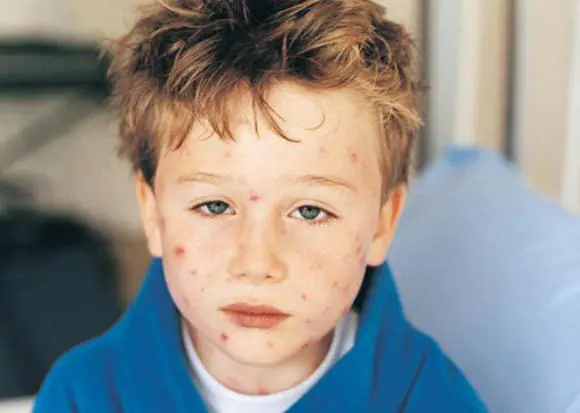
One of the best proven acne treatments is salicylic acid. You can use tar soap and mash. It is prepared in pharmacies according to a doctor's prescription. Apply in the evening with a cotton swab to the face. For external use, brewer's yeast is also good for getting rid of acne. During treatment, you must follow a diet: avoid carbonated drinks, spicy and fatty foods.
Acne in adults
Why do you get acne on your face at 30? Not only teenagers suffer from this problem, but adults can also experience inflammation of the subcutaneous tissues. There are several main reasons why adults also develop acne:
- Hormonal imbalance. In women, this often happens during menstruation or pregnancy.
- Diseases of the gastrointestinal tract.
- Hyperkeratosis (keratinization of the skin). Small “scales” appear. The sebaceous glands work very actively; waste and bacteria accumulate in their mouths. This is where acne and pimples form. This is a very serious and dangerous skin disease that is very life-threatening.
- Demodex mite. One of the most common reasons. Every person has this mite, but it is usually activated when the immune system is weakened. What causes pimples with pus on the face? This is just typical for demodex. Along with inflammation, a general redness of the skin is observed. The disease is treated by a dermatologist. At home, you need to change your bed linen more often.
- Stress.
- Poor hygiene.
- Cosmetical tools.
- Squeezing pimples. After removing one, a dozen new ones may appear.
After squeezing out pimples, wounds remain on the skin, in the treatment of which the cream with a bactericidal and wound-healing effect “ARGOSULFAN ®” has proven itself well. Unlike many antibacterial ointments that have long been familiar to us, to which microbes have developed resistance, it contains silver sulfathiazole, to which bacteria do not become accustomed. The active substance of the cream “ARGOSULFAN ®” has a wide spectrum of antibacterial action and promotes rapid healing of the wound without the formation of a rough scar.
There are contraindications. You need to read the instructions or consult a specialist.
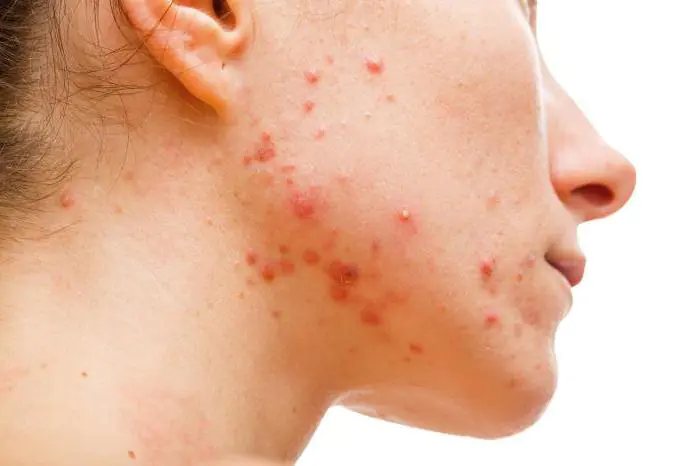
For treatment, it is necessary to correctly determine the cause of acne. But in any case, it is necessary to spend less time in the sun, maintain hygiene and diet, and also take vitamins.
Why do blackheads appear on the face?
What causes pimples and blackheads on the face? Contaminated skin and poor skin care are often to blame for this. Especially if there is no daily cleansing. Poor quality cosmetics are another cause of blackheads and pimples. There are several more reasons:
- deterioration of health;
- hormonal imbalance.
How to destroy acne?
Acne needs to be treated only comprehensively. This includes:
- constant facial cleansing;
- restoration of hormonal levels;
- restorative procedures for the skin;
- fight against pathologies and diseases that cause acne;
- face massage;
- masks;
- medicines;
- hardware therapy methods.
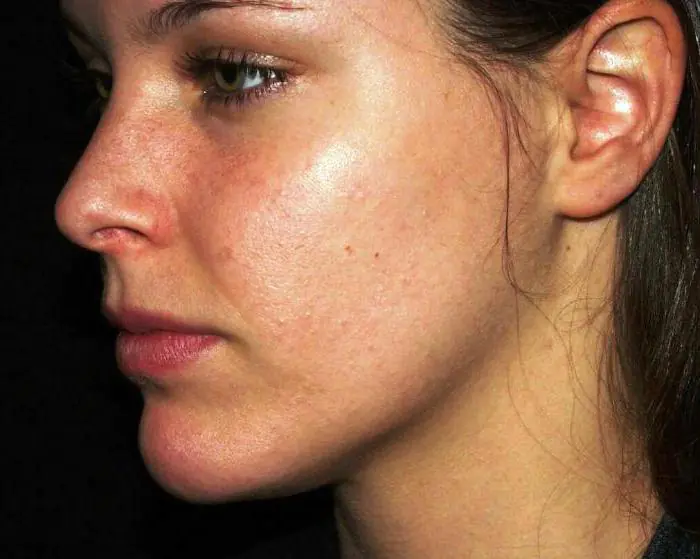
What causes acne on the face? They often occur due to poor nutrition. Therefore, it is even more important to follow a diet during treatment. Especially if you are getting rid of acne. It is necessary to exclude protein-enriched, fatty, spicy and salty foods. As well as chips, carbonated and alcoholic drinks, flavored teas, and sweets. You should give preference to fish, cereals, poultry, vegetables and fruits.
Treatment of acne with green tea
Green tea helps effectively fight acne. It is a good antioxidant and antibacterial agent. Green tea can be used as an herbal supplement or made into a cream. After brewing, the leaves are applied to the face like a mask. But first, the face must be thoroughly cleansed and rinsed with water. In China, to kill acne, green tea is drunk with honeysuckle, but without sugar, as it neutralizes the healing effect.
Treatment of acne with folk remedies
You can try to cure acne on your own. There are folk remedies that people have used since ancient times. All of them are used after preparation in the form of lotions.
- from the leaves of aloe vera;
- calendula with honey;
- from sage leaves.
- St. John's wort;
- from birch buds.
Medicines to treat acne
What causes acne on the face? Whatever the cause of their occurrence, this is subcutaneous inflammation. Since ancient times, acne has been treated with extracts of witch hazel and chamomile. Triclosan, salicylic acid, zinc oxide and vitamins A, B, C help well. When using these drugs, the layer of sebum decreases, as does the process of inflammation in the follicle and skin. All of these drugs have an antibacterial effect. Pharmaceutical products for acne are divided into two groups: for external and internal use.
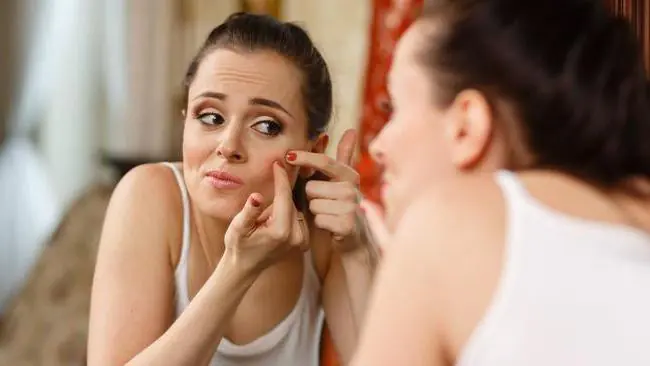
For external use:
- Retinoids that target the cause of acne. Suppresses the growth of skin cells, prevents and reduces clogging of pores.
- Antibacterial agents act specifically on bacteria. These drugs include antiseptics and antibiotics.
- Azelaic acid agents inhibit cell division. And this ensures the patency of the excretory skin ducts. These drugs have antibacterial properties. Azelaic acid is found in Aknestop cream and Skinoren gel.
How to deal with acne?
After the appearance of rashes on the skin, the question arises: “What causes acne on the face and how to deal with it?” You can try cosmetics, for example:
- Antibacterial soap. But you cannot use it constantly, but only from time to time.
- Cleansing gels regulate the formation of sebum.
- Anti-aging emulsions-creams prevent micro-inflammations.
- Normalizing gels. Antibacterial agents moisturize the skin and remove excess oil.
- Masking pencils. They have an antibacterial effect and dry out acne. Apply at the first stage of inflammation.
- Moisturizing emulsions prevent acne and moisturize the skin.
Device therapy uses several technologies. For example, a complex pulse consisting of a radio frequency range and a light spectrum. When it hits an inflamed area, the impulse affects the cause of acne. There are other technologies.
What causes acne on the face? You need to pay closer attention to your skin. Perhaps the pores are clogged, there are a lot of dead cells, etc. This can be corrected with chemical peeling, which removes a large layer of the epidermis. This uses glycolic and salicylic acid. To combat acne, superficial peeling is also performed. Laser therapy is sometimes used.
It is difficult to find a person who would be completely satisfied with his appearance. Some struggle with wrinkles, some are bothered by freckles, and others are completely driven crazy by age spots. But most often, problem skin is associated with acne. As a rule, they appear in adolescents during puberty and hormonal changes in the body. But it happens that a pimple pops up in a mature woman, upsetting her with its reflection in the mirror. In this article we will try to understand what a pimple is, why and how it appears, and also tell you about the main methods of treating acne.
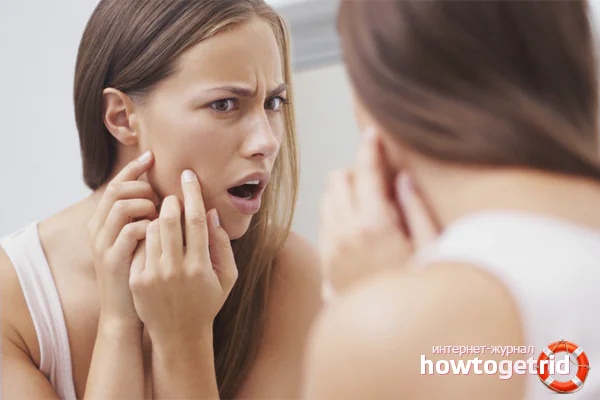
Causes of acne on the face
A pimple is an inflamed area of skin that may be red, swollen, and have a white, pus-filled eye. Acne usually appears in those with oily skin. Sebaceous fat is more actively produced on the face, neck, back and chin, so most often acne is localized in these areas of the skin. A large amount of produced sebum clogs the duct, forming comedones. If there were germs or bacteria in the pore, inflammation begins, because sebum is an excellent food for pathogens. If the inflammation is severe, leukocytes enter the battle - they try to suppress the activity of the pathogenic flora. Leukocytes form pus - a white liquid mass. Depending on the pathogen, pimples can be different - internal, superficial, swollen, red. But often a pimple is more than just dirty, oily skin. As a rule, the disease has a number of causes that provoke it.
- Hormones. This is the most common cause of acne. Acne is often observed in teenagers, pregnant women, and also in girls before the start of their menstrual cycle. Most often, acne appears when the hormone testosterone increases. This is a male sex hormone that activates increased production of sebum, which is food for pathogenic bacteria. If testosterone increases greatly in a woman, this is accompanied by increased body hair and various disturbances in the functioning of the ovaries.
- Oily skin. Normally, sebaceous fat is very necessary for our skin. It protects it from drying out and sun rays. People with oily skin face wrinkles much later because their skin is constantly hydrated. However, for various reasons, the skin may be too oily. If fat is produced so quickly that it does not have time to be distributed over the surface, it accumulates in the hair and sebaceous ducts. And this is an excellent environment for the development of pathogenic flora.
In addition, the type and sensitivity of the skin to various factors is transmitted genetically. We can say that acne is a hereditary disease. If your parents have skin problems (or had them in adolescence), you should treat your face more carefully.
Drug treatment of acne
Pharmacies offer a wide range of medications for the treatment of acne. For treatment to be effective, it must be comprehensive. Medicines should clear the ducts, reduce the amount of oil produced, suppress the development of bacteria on the skin, relieve inflammation, and prevent the formation of blackheads, because blackheads are the harbingers of acne. We will present to you the most effective and efficient remedies that can be useful in the fight against acne.

- Antibiotics. To identify pathogenic microflora, a smear is given for bacteriological culture. The same analysis helps to identify antibiotics to which the body is sensitive. After this, the doctor prescribes an antibiotic orally or for external use, depending on the degree of development of the disease.
- Hormones. Hormonal drugs are very effective in the fight against acne if treated correctly. First, you need to donate blood for hormones and identify which hormone deficiency (or excess) causes acne. Depending on this, the tactics of hormonal therapy are selected.
- Sorbents. Sometimes taking simple sorbents can get rid of acne, especially those that appeared after uncontrolled consumption of harmful foods (this often occurs during the holidays). Activated carbon, Filtrum, Enterol and other sorbents can cleanse the intestines and skin.
- Antiseptics. This is a large group of antiseptic lotions, ointments and gels aimed at suppressing various bacteria on the surface of the skin.
- Immunomodulators. Immunomodulators are prescribed when acne is caused by a decrease in the activity of the body's defenses.
- Retinoids. Retinoids are a group of drugs that suppress the active production of sebum, the skin becomes less oily, and the number of acne decreases. Retinoids are effective not only against acne - ointments are actively used in the fight against wrinkles.
In serious cases, along with drug treatment, cosmetic procedures are prescribed - ozone therapy, laser treatment, mesotherapy, skin cleansing (mechanical or ultrasound). Remember, before you start taking this or that drug, it is better to consult your doctor.
How to get rid of acne at home
Here are several effective methods that have been proven over the years that will help you suppress the activity of the sebaceous glands, disinfect the skin and clear it of blackheads.
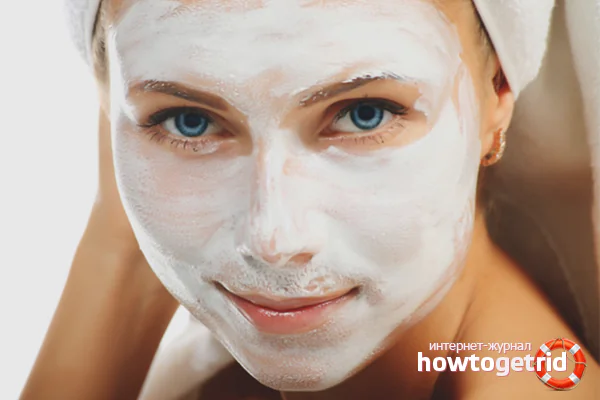
- Lemon juice, coffee and yogurt. This is a great homemade scrub recipe that will remove the surface layer of skin and prevent oil from clogging your pores. Mix the ingredients in equal proportions and massage your face. Coffee should be natural so that its particles gently cleanse the skin. Lemon creates a chemical peeling - it eats away dead skin particles. Coffee instead of a brush removes dead scales. And the yogurt in this mask provides nutrition and hydration. Home peeling should be done once a week so that after renewal the skin does not become clogged again.
- Calendula and white clay. Clay perfectly cleanses the skin, removing impurities from the pores. Calendula has bactericidal and antiseptic properties. Prepare a strong decoction from the plant - a tablespoon of inflorescences in half a glass of boiling water. Strain the mixture and mix it with clay to form a viscous mass. Apply to skin and rinse after 15 minutes.
- Aspirin. A simple aspirin will help dry the skin and suppress inflammation. The tablet must be crushed and mixed with water to form a thick paste. Apply the mixture directly onto pimples and wash off your face after 20 minutes.
- Aloe. This is an excellent remedy for acne - it has healing and anti-inflammatory properties. It is quite difficult to squeeze juice out of an aloe leaf, so we will use this method. Freeze the clean and washed leaf, and then grate it into a solid form. Squeezing juice from green mass will be as easy as shelling pears. Apply aloe juice to inflamed areas of your face to get rid of acne.
- Honey and oatmeal. This recipe is used to combat problematic and oily skin. Mix heated natural honey with oatmeal. Apply the mask to your face and then wash off after 20 minutes. Honey is an excellent antiseptic; it can be used to suppress inflammation. And oatmeal will absorb excess sebum and normalize the functioning of the sebaceous glands.
- Parsley, lemon and cucumber. This recipe will help you get rid of scars and dark marks left behind by acne. Mix the juices of the three ingredients and apply the mixture to the scars. Rinse off the composition after 10 minutes. Each of the three components has a powerful lightening effect; the scar can be eliminated in 3-5 procedures.
- Brewer's yeast. Brewer's yeast, which you can buy at the pharmacy, will help get rid of acne. Apply them to clean facial skin twice a day.
- Decoction of birch buds. This is an excellent remedy for treating acne and other inflammatory processes. Three tablespoons of birch buds should be poured with boiling water and left for at least 6 hours, wrapping the jar in a warm towel. The prepared decoction can be used for washing, compresses and lotions are prepared from it, and used as part of other masks. If there is a lot of broth, it can be diluted with alcohol and kept in the refrigerator. You will get an effective anti-acne lotion, which you need to wipe your face every day.
These simple recipes will help you get rid of acne on your own. Try and alternate between them to find the one that really helps clear your skin.
Rules for caring for problem skin
Hygiene is very important in the fight against acne. To get rid of acne forever, you need to reconsider the quality of your life. Pay attention to what you eat - the contents of your intestines are reflected on your face. Avoid sweet, fried and fatty foods. Give preference to fresh vegetables and fruits, cereals, lean meats, and dairy products.
Instead of a cloth towel, use disposable paper napkins to avoid contaminating your clean face with a used towel over and over again. Do not squeeze pimples under any circumstances - you will only injure the skin and contribute to the spread of bacteria. Visit a cosmetologist regularly to prevent relapse of the disease.
It is very important to avoid provoking factors. Raise your immunity by hardening, physical activity, and proper nutrition. Try to be less nervous, avoid allergens. Take care of the condition of your skin - thoroughly clean it of makeup in the evenings, exfoliate once a week, use high-quality and light cosmetic products that do not clog pores. All caring cosmetics should suit your skin type. Do not take any medications without a doctor's prescription. If acne appears after taking the drug, talk to your doctor about replacing it with more gentle analogues. If your skin is oily, do not overuse steaming - this increases the amount of sebum produced and expands the pores. These are the basic rules for caring for problem skin that you should pay attention to.
If you can't deal with acne on your own, don't put off visiting a doctor. Perhaps the cause of the disease lies inside the body, sometimes acne is only a symptom of something more serious. Don't rely on chance; what worked for your neighbor or friend may not be effective in fighting your acne. Only after finding out the exact diagnosis and the cause of acne can you choose further tactics of action. Do not be indifferent to your skin, because it reflects the internal state of your body.
Video: how to treat acne
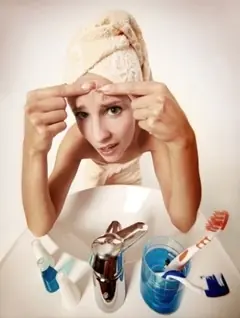
In the fight against acne, the initial task is to find out the causes of their occurrence.

If you suffer from acne, it is recommended to visit an endocrinologist and check your hormonal levels.

In some cases, acne may be the result of an allergic reaction.
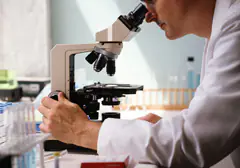
Demodicosis is a disease caused by the microscopic Demodex mite, which can cause progressive acne and pimples.

Acne often occurs in people suffering from intestinal dysbiosis.
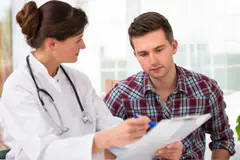
Weakened immunity sets the stage for various ailments that can cause, including acne.
Morning, you set the coffee to brew and rush to the bathroom for a morning shower. The day promises to be wonderful, long and full of meetings and discoveries. However, one look in the mirror and the good mood disappears... Acne, or acne, this scourge of youth, grows older every year. And now, even at 40 years old, no one is protected from it. However, let's understand the causes of acne and the means to combat acne.
City air, consumption of fast food and other factors significantly prolong the period of activity of the sebaceous glands and expose the skin to additional stress, which makes this disease a disease of all ages. However, undoubtedly, it is the teenage and post-adolescent periods of hormonal “bursts”, the beginning of which is signaled by the appearance of acne, that are distinguished by the most active manifestation of this skin disease of the face, and sometimes the body.
Causes of acne on the face, types of acne
So, the most common cause of acne on the face is hormonal changes in the body. Of course, adolescence is the most striking example of this. In a person’s life, this is the period of greatest hormonal activity. A hormonal storm rages inside the body, and outside we see its consequences - a roughening voice, changing body proportions and, alas, acne. Few people manage to avoid this scourge - teenage acne. Even if growing up proceeds within normal limits and the skin is quite thin and problem-free, it is impossible to go through puberty without a single pimple - they will appear, even if only in single quantities.
Similar work of the hormonal glands also occurs in women during pregnancy and a certain phase of the menstrual cycle (and this can also be accompanied in some cases by acne) or with certain endocrine problems in adults. Even newborn babies exhibit conditions similar to acne - they also have a hormonal nature, even a separate name - hormonal crisis. In addition, some medications, specifics of work, even inhaled air - all this can become a pathogenic factor for acne.
Actually, the word pimple is not exactly a medical term, or rather, its meaning is too vague. Experts distinguish the following types of acne:
- Comedo. This is not even a pimple, but a “pre-pimple” or a so-called white pimple. A comedon is a sebaceous plug that clogs a pore, causing future inflammation. In everyday life, comedones are also called “blackheads”; black color is the color of oxidized sebum on the surface of the comedones. If a plug has formed in the upper part of the pore, this is an open comedon; on the surface of the skin it appears as an easily removable tubercle filled with liquid. A closed comedon is, accordingly, localized deeper in the pore. On the skin it appears as a dense white ball, a wen. If such a comedone gets infected, a papule develops.
- Papule. This is already a full-fledged pimple, it is inflamed and painful on palpation, which is why its color can vary from red to bluish. When pressed, it turns pale, then becomes filled with blood again.
- Pustule. May be primary. Capable of emerging from a papule. It differs from the latter in the presence of purulent contents, which emerge on the surface of the pimple as a white dot. Papules and pustules have the common name “red pimples.”
- Nodular cystic acne. Severe form of pustules, which are no longer single, but form conglomerates penetrating deep into the dermis; they are connected by fistulous ducts and are quite painful. They require serious systemic treatment.
- Lightning acne. The most severe form of acne is accompanied not only by large areas of acne, but also by hyperthermia, muscle and bone pain, and changes in the leukocyte formula of the blood. Requires immediate medical attention.
Depending on the type of rash, there are four degrees of acne severity:
- First degree. A local area of the face is affected (for example, the forehead or chin). Rashes in the form of comedones, occasionally papules and pustules.
- Second degree. It differs from the first degree quantitatively - a large surface of the face is affected, there are rashes on the body. The qualitative composition of acne is the same as in the first level disease - comedones, single papules and pustules.
- Third degree. In addition to comedones, there are many papules and pustules, the inflammatory process is pronounced, and hyperemia (redness, itching) of the skin is possible. Traces of acne.
- Fourth degree, the heaviest. Large spherical pimples (more than 5 mm), bluish-red in color, penetrate deep into the layers of the dermis and leave behind deep atrophic scars (they look like pits on the skin).
Table 1. Classification of acne (causes and types)

In addition to these factors, the severity of acne can also be determined by skin genetics. The production of sebum and the possibility of seborrhea (hyperactivity of the sebaceous glands) depends on the thickness of the skin of a particular patient.
Table 2. Intensity and area of acne spread for different skin types during puberty
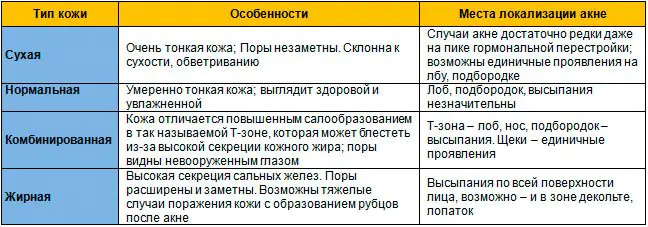
Remedies for acne and acne marks
When we talk about acne prevention, we, of course, mean the first two mild degrees of acne. Under no circumstances try to deal with serious boils, nodular cystic or fulminant acne on your own - this can be fraught not only with serious skin problems, but also with sepsis in especially severe cases.
However, if we are talking about mild acne lesions, treatment, which essentially boils down to the prevention of the disease, can be independent. Of course, this should be done correctly, because any irritation of the acne will indicate their growth. Cosmetologists categorically prohibit any unprofessional squeezing of pimples or comedones - this is fraught with the formation of new, more complex pimples, as well as the formation of atrophic scars, the fight against which is much more difficult than with mild degrees of acne, which go away without consequences for the skin. In general, experts recommend:
- review your diet during the period of highest activity of the sebaceous glands, that is, exclude fatty, sweet foods rich in simple carbohydrates;
- increase facial and hand hygiene measures. This will contribute, if not to the complete disappearance of acne, then at least to their non-proliferation due to external factors;
- regularly use antiseptic masks and creams that protect the pores from the penetration of dirt, dust particles and bacteria, which, in fact, trigger the inflammatory process.
Let's take a closer look at the last point. Humanity has been struggling with acne for more than a millennium, and during this time many folk and pharmacological drugs have been invented that cope with acne with greater or lesser success.
Table 3. Types of medications used for mild cases of acne
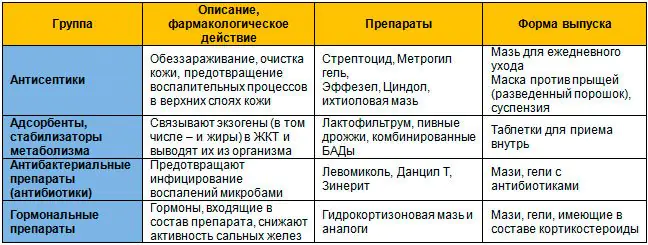
All these products should be used with caution, with mandatory testing on a small area of skin. Despite the fact that many ointments and gels are supported by vitamin complexes and special nutrition for the skin, during the treatment period much attention should be paid to daily facial care. Oily skin does not mean moisturized. Suspensions and creams can dry out the skin, peeling and itching can become an additional factor in its irritation and infection. Regular disinfection kills not only pathogenic, but also the skin’s own protective flora, also making it vulnerable. All this should be taken into account when starting treatment with acne creams and ointments. Antibacterial and hormonal drugs should be used with particular caution, treatment of which should definitely be carried out under the supervision of a doctor and involves undergoing numerous tests. It should also be remembered that acne leaves pigmentation on the skin, which, although it goes away over time, also requires additional attention. Cosmetology will also help speed up the depigmentation process - whitening clay masks, creams with high UV factors that protect against solar pigmentation. It is impossible to remove atrophic scars with pharmacological means - this problem can only be solved in beauty salons with laser resurfacing and other means of hardware cosmetology.
Determining the causes of acne on the face
Getting rid of acne will be truly effective only if it is under the supervision of a specialist. Even a mild form of the disease, if prolonged, indicates problems with hormonal levels or with the functioning of internal organs. Therefore, it is best to consult not only a cosmetologist, but also an endocrinologist, who will prescribe the necessary tests, select the right diet, and determine the optimal treatment strategy and tactics. Contrary to popular belief, this is a shorter and less expensive way than constantly thoughtlessly changing jars and tubes in the hope of “maybe”. Any treatment begins with laboratory and hardware diagnostics, which can be quickly and comfortably carried out in the INVITRO network of modern laboratories. They are located in almost all districts of Moscow.



